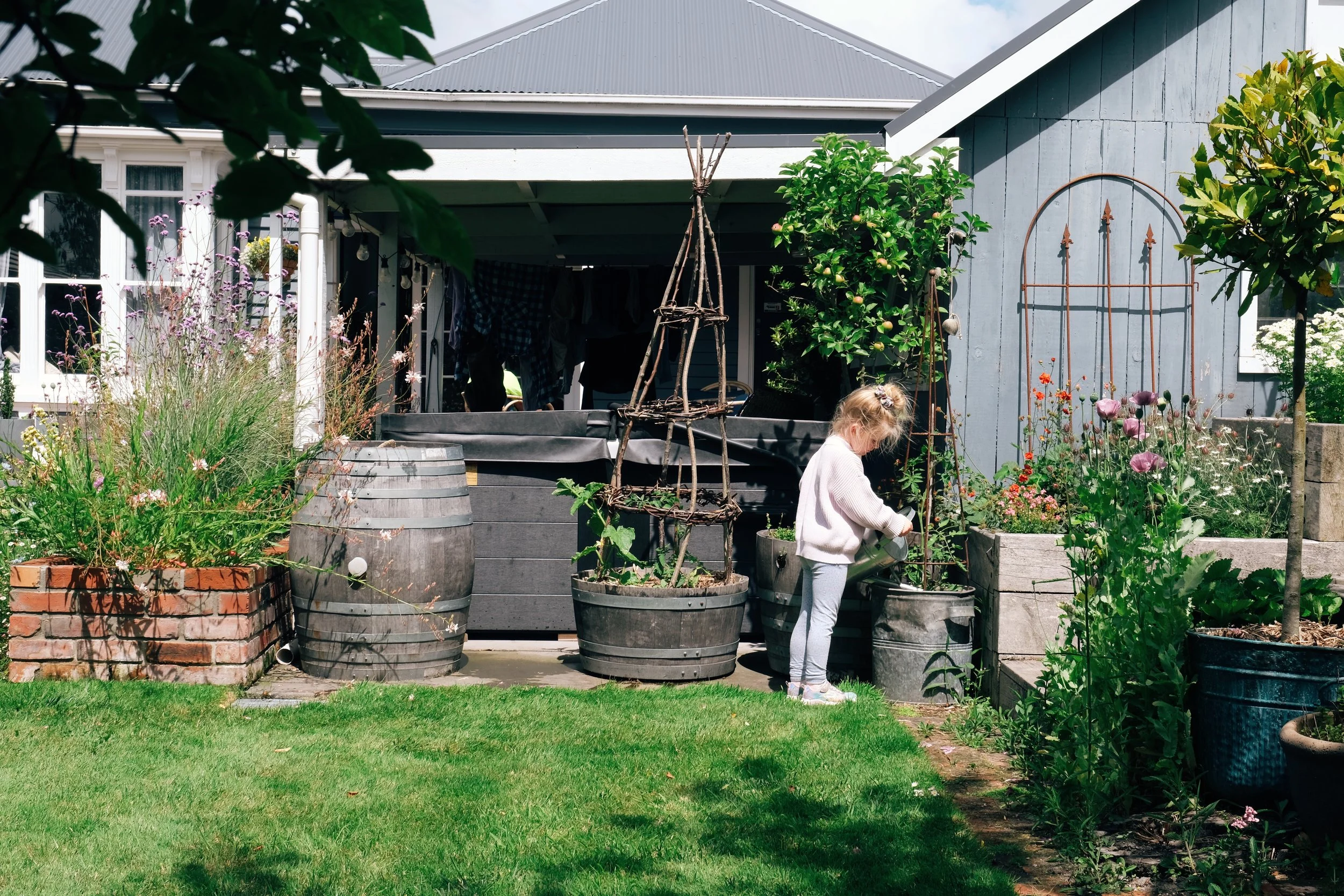Planning for and watering in the dry
/With the projected shift to an El Niño cycle on the horizon, spelling hot dry winds for my own garden, I have been thinking a lot about the make-up and position of my planting, considering ideas to safeguard it should we find ourselves very hot and dry next summer.
In the years since I began my gardening adventure, I have come to realise that a good watering practice is all very well but tends to be a reaction to the season as opposed to getting ahead of challenging dry periods through good planting and preparation.
When I contemplate drought-resilient gardens, I immediately think of my friend Jenny Cooper of the inspiring Blue House in Amberley. Jenny takes water conservation seriously and has waded through years of research and experimentation to establish beds of beautiful but strong plants that she resists watering wherever possible.
I banked a lot of the valuable information from her staunch approach when designing my own beds. Her advice of “if you can’t give a plant water, give it shade”, and “resist installing irrigation in new beds to avoid relying on it” have bounced around my head with every decision I’ve made.
However, any attempts to feel smug about my new planting combinations have been thwarted by the consistent top-ups of rainfall this last spring and early summer. Due to this, my plans are yet to be truly tested.
My neice Ada watering the veges
Recently I have been enlightened by the definition of two terms we gardeners tend to use interchangeably. When learning about plants that catch your eye or ones you are specifically investigating for climate-resilient beds, I’ve found it helpful to understand the important difference between those labelled “drought tolerant” and those that are “drought resistant”.
The former refers to plants that have evolved to happily exist in long periods without water, often fleshy specimens like cacti and succulents. These are in slight contrast to drought-resistant plants that will cope with extended periods of dry, but, by nature, enjoy moderate watering, too, like many prairie plants.
Below is a list of plans that I have considered for my own garden in lieu of dry periods and water restrictions.
Planning for the dry
Do your research and stocktake the behaviour of your plants this summer.
Ideally, you want to create beds with plants sharing the same watering needs.
Even the best planning will reveal the odd sad and wilting specimen when the going gets tough despite its neighbours holding strong. To avoid turning on the watering to appease the odd thirsty plant, instead look at places you might be able to move it this autumn, where it is in better company.
Consider shade.
Rather than full shade, I refer to planted areas that might include airy trees in their midst that will take the sting out of intense midday or afternoon sun.
If that’s not an option, consider planting tightly or picking plants that create dome-shaped clumps to shade the earth below and reduce evaporation during the heat.
Start a good mulching practice now.
Research your best-suited mulch and get onto this as soon as possible. For my small urban garden, I prefer pea straw, as it is easy to handle and shift around my soft perennial planting. It also aids in enriching and loosening up my clay soil, helping with improved drainage over time, which many of my favourite drought-resistant plants prefer.
I mulch twice a year, with a top-up in autumn as my perennials recede, and a good layer in spring that will see me through summer. Mulching provides an all-important barrier between your earth and the elements, vastly improving the condition and drying out of the soil. I am shocked at the positive difference this has made in my own garden.
Find ways to store water.
There are many options available these days for capturing and storing rainwater that would otherwise disappear down the drain. At home, we have converted a wine barrel into water storage, utilising a basic downpipe diverter to fill up the tank when raining.
While a single barrel wouldn’t last all that long during water restrictions, it’s certainly better than nothing and I have surprised myself at its convenience. With a simple dunk of my watering can, I can spot-water my cucumbers and tomatoes with little effort while avoiding turning on the irrigation system for my whole veggie garden. ·It also feels very wholesome and rainwater contains nitrate that will make your plants glow with well-being!
Avoid pot city.
As someone who gardened with an extensive collection of potted plants in my first few years, I can attest that they are very demanding in the height of a dry summer, often requiring daily or twice daily watering. If you thought a pet was a handbrake from going on holiday, try gardening in pots!
However, needs and wants may still call for pots, so, where possible, try to utilise the biggest pots you can fit. I have also found that mulching around the potted plants has definitely reduced watering needs, making them slightly less of a pain.
WATER MANAGEMENT DURING THE SUMMER
Water deeply, but less frequently.
For ornamental beds, rather than having the irrigation set to come on daily at a certain time, physically monitor your garden by plunging a finger into the earth and considering its dampness. If it’s dry at your fingertip, then watering will be called for.
Short, regular doses of water encourage plants to keep their roots near the surface, making them fragile, weak and extremely reliant on you.
Instead, once you have recognised the earth is dry, water your beds deeply for 45 minutes or so. Waiting for beds to properly dry out between watering encourages resilience in your plants and avoids overwatering, which presents a new set of issues.
In the past, during the height of summer, I have tried to water just once a week. Jenny Cooper, on the other hand, would consider it every three weeks. This is a lesson in plant choice, position and mulching techniques!
Know your plants.
Vegetables are mostly much more thirsty than ornamental plants and they will demand more watering attention than others in your garden.
When selecting drought-resistant plants, it’s important to note that many of these may need a little more watering as they get established before reaching their resilient potential.
Water at the ends of the day.
It’s common knowledge that watering in the morning before the intense heat of the day is best, however, evenings can be much more convenient for many.
The main aim here is to avoid spraying your valuable resource into the midday sun where it will evaporate at speed and risk burning the leaves of your plants in direct sunlight.
This is an expanded version of the article featured in my Stuff ‘Homed’ gardening column - published online as well as in The Press, Dominion Post and other regional papers on January 5th 2023.
All words and images are my own, taken in my home and garden in Christchurch, New Zealand unless otherwise captioned.






